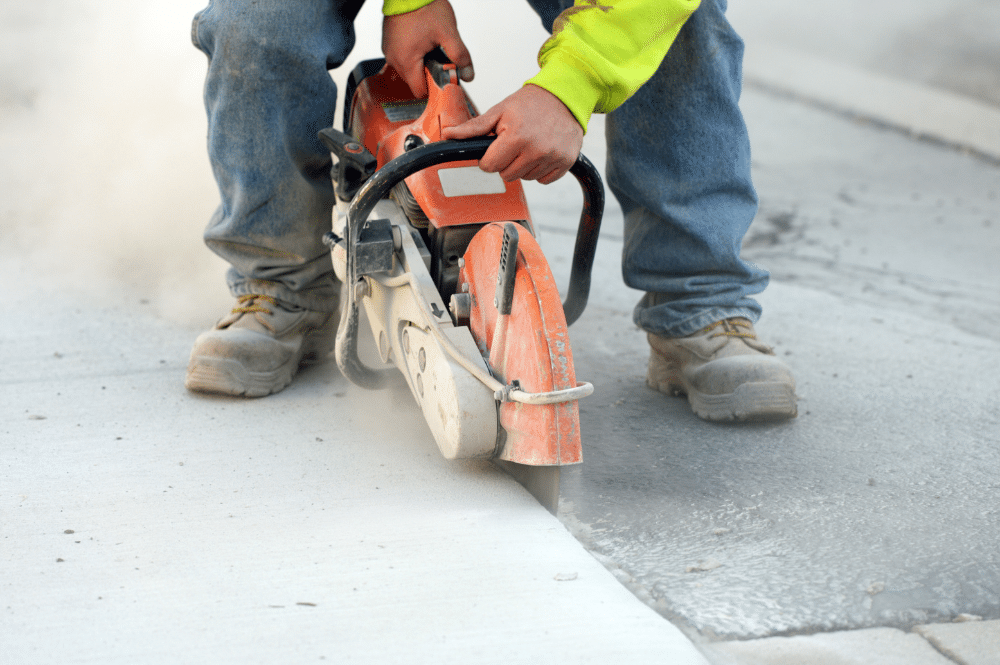In years past, if you wanted to cut through concrete, it was all about swinging sledgehammers and being comfortable with a chisel. Fast forward to now, and it’s a whole new ball game. Today, we have innovative machines and high-tech gear that can cut through concrete like it’s butter. But here’s the thing: having the right tools is only part of the story. You need to know how to use them without turning the job site into a disaster movie.
That’s where J.P. Hogan Coring & Sawing Corp. steps in, with years’ worth of fancy equipment and a reputation for making cuts so precise, they could be in a museum, at J.P. Hogan, we are your trusted partner for concrete cutting. Continue reading for insights on the history of concrete cutting, and what we see as innovations coming in 2024 and beyond.
History and Evolution of Concrete Cutting
When people first started building with concrete, they had to get creative to shape it. They used chisels, hammers, and other manual tools that took a lot of effort and time. Accuracy? Not even in the vocabulary. But then, like most things, technology helped to improve the process.
Innovations in Concrete Cutting Techniques
So, what changed? Diamonds. Not the bling kind, but diamond-tipped cutting systems. This was a game-changer because diamonds are tough, and they can slice through concrete easily and without manual labor. In addition, high-tech machines that saw, drill, and do all the heavy lifting also became available.
And speaking of advancements, companies like J.P. Hogan Coring & Sawing Corp are at the forefront. We’ve got all the tools needed to get the job done, like hand-held core drills, crawler wire saws, and some next-level grinders. We’ve worked on some big-name projects, too. Check out our services to see how it’s done right.
Concrete Cutting in the Construction Industry
Now, concrete cutting is a big deal in construction. It’s not just about making things look nice; it’s about precision and safety. It plays a crucial role in everything from building skyscrapers to paving roads. And, it’s only going to get more advanced from here.

Tools and Equipment for Concrete Cutting
Concrete cutting is like the ultimate mix of power and precision. Let’s break it down and check out the kind of tools the pros use, including those at J.P. Hogan.
Types of Concrete Saws and Blades
Ever seen someone whip out a saw that looks like it could take on a zombie apocalypse? That’s probably a handheld concrete saw. These tools are perfect for quick, small jobs. But when you’ve got to cut deep or handle tough projects, walk-behind saws are going to provide more power. They’re like the heavy lifters of concrete cutting.
Now, about the blades—think of them as the secret sauce. You’ve got two main types: diamond and abrasive. Diamond blades are the elite. They’re durable and can cut through concrete like it’s cake. Abrasive blades are cheaper, but they wear out faster, so they’re kinda like the disposable heroes of the blade world.
To keep these tools in top shape, you’ve gotta give them some TLC—regular maintenance is key. Think of it like taking care of a car. You wouldn’t skip oil changes, right? Same deal here.
When you’ve got a job that needs some next-level precision, you bring in the big guns like wire saws and wall sawing systems. These machines can handle the intricate cuts that handhelds can’t touch. And for creating openings in concrete without making a mess, core drilling equipment is your go-to.
But wait, there’s more! Hydraulic and high-frequency cutting tools are like the ninjas of concrete cutting. This gear can cut through reinforced concrete and stone, all while keeping noise and dust down.
Safety and Protective Gear
Concrete cutting isn’t a joke. It’s hardcore, and it can be dangerous. That’s why personal protective equipment (PPE) is the real MVP. We’re talking hard hats, eye protection, ear muffs, and tough gloves.
Now, the machines themselves also have some impressive safety features. Things like guards, kill switches, and dust collection systems. They’re designed to keep our workers safe while turning concrete into art.
And let’s not forget about training. Knowing how to handle these machines safely is just as important as the gear itself. It’s like knowing how to drive before you hit the road. Safety first, always.
Techniques and Best Practices in Concrete Cutting
There’s a science to cutting concrete.
Preparing for a Cutting Project
Before you even power up a saw, there needs to be a plan. First off, you need to assess the work area. You’re looking for any obstacles or hazards that could potentially cause damage. Next, you’re going to want to mark and measure where you need to cut because precision is key. Then, there’s dust management. You’ll need water or vacuums to keep it under control to protect both the workers and the environment.
Cutting Techniques for Different Concrete Types
Not all concrete is created equal, and neither should your cutting technique. Cutting reinforced concrete? You’ll need diamond-tipped blades. Non-reinforced concrete is easier to handle but still requires the right tools and patience.
And then there’s decorative concrete cutting. This is where you get fancy, creating patterns and designs with total precision and creativity.
Troubleshooting Common Cutting Challenges
You’re bound to hit some snags but don’t sweat it. Here are a few tips:
- If you’re dealing with tough materials or hitting unexpected obstructions, like buried pipes, you’ll need to switch up your blades and maybe even your approach.
- The weather can mess with your plans too. If it’s too hot or too cold, concrete can behave differently, so adjust your methods accordingly.
- Lastly, keep your gear in top shape. A blunt blade is like trying to write with a dull pencil—frustrating and inefficient. Routine maintenance on your equipment can save you a world of hurt.
Applications of Concrete Cutting in Industry
Concrete cutting is like sculpting, but instead of clay, you’ve got this tough-as-nails material, concrete. And it’s not just about brute force; there’s some real finesse to it.
Residential and Commercial Construction
When you’re building a new house or updating your business space, you need to make room for all the essentials – doors to walk through, windows to gaze out of, and pipes and wires that bring your place to life. That’s where concrete cutting comes in. These pros carve out the perfect spots to fit all these things with laser-sharp precision.
- Creating openings for doors, windows, and utilities: Imagine trying to shove a square peg into a round hole – it’s a no-go, right? Well, cutting concrete is how you make that peg fit. Whether it’s a door that leads to your dream room or a window that brings in that morning sunshine, it’s all about crafting the right space.
- Expansion joint cutting for crack prevention: These cuts give concrete the room to expand and shrink without turning your floor into a jigsaw puzzle.
- Custom cuts for design and aesthetics: And it’s not just about function. Sometimes you want that concrete to look snazzy, with curves and patterns that make your neighbors say, “Wow!”
Infrastructure and Renovation Projects
Now, think bigger – like city-scale big. Concrete cutting is key for fixing up old bridges, roads that have seen better days, and even sprucing up historic buildings.
- Bridge and roadway cutting for repair and maintenance: It’s like giving the roads and bridges a spa treatment so they can handle all those cars without breaking a sweat.
- Retrofitting and repurposing existing structures: This is where you take an old building and give it a new life. Maybe it’s turning an ancient factory into swanky lofts or updating that old school into a community center.
- Historical preservation and careful demolition: It’s all about keeping history alive. When you’ve got a building that’s a blast from the past, you can’t just go in there swinging a wrecking ball. Concrete cutting lets you make the updates you need without turning history into dust.
Specialized Cutting for Unique Projects
And then, there are the projects that are out of this world. These projects could be underwater construction – try holding your breath while cutting concrete, right? Or making massive sculptures that’ll make people stop and stare.
- Underwater cutting for marine construction: This is like being a Navy SEAL but for construction. It’s all about making cuts below the waves, where precision is even more crucial because you’re dealing with water, pressure, and all that jazz.
- Precision cutting for art installations and sculptures: It’s not all straight lines and corners. Sometimes you need a touch of an artist to carve out pieces that are more like modern art than part of a building.
- High-precision cutting in sensitive environments: Imagine operating in a place that’s as delicate as a house of cards. One wrong move and everything comes tumbling down. That’s why these pros are all about precision, making sure every cut is exactly where it needs to be.
Environmental and Safety Considerations
So, when we’re talking about concrete cutting, it’s not just about slicing through some tough material with innovative tools. There’s a whole other side to this gig that’s important—taking care of our planet and making sure nobody gets hurt.
Reducing Environmental Impact
Picture this: You’ve got these massive machines tearing through concrete, and it can get pretty messy. But, the pros at J.P. Hogan? We have water management processes in place, which are not only smart for the environment but also keep the dust down. Speaking of dust, we also make sure that the dust doesn’t impact the surrounding area. And when it comes to all the leftover concrete, we don’t just chuck it—we recycle that too. It’s all about leaving the smallest footprint possible.
Safety Regulations and Compliance
Safety is a critical component of any concrete cutting project. We stick to OSHA standards like glue and are sure to follow all the local rules, requirements, and regulations. Plus, we make sure everyone knows their craft inside and out through training and certifications. It’s like having a safety net so you can work without worrying about things going south.
Innovations in Sustainable Cutting Practices
At J.P. Hogan, we are all about the latest tech, like electric gear that cuts down on fumes. We’re on the hunt for ways to cut concrete without trashing the place. And we’re not just following the green construction trend—we’re leading the charge.
And guess what? All this matters big time. Not only does it make J.P. Hogan stand out as a company that cares, but it also means we can take on jobs that need a delicate touch with the environment. That’s a win-win.
So, while we’re all about getting the job done, we can’t forget about the world around us. It’s like being a superhero, but instead of capes, we’ve got diamond-tipped saws and a whole lot of responsibility. Next up, we’ll ease into something just as important—the future of concrete cutting.
The Future of Concrete Cutting
At J.P. Hogan, we’re all about slicing through that tough material like it’s butter, making sure everything fits just right in buildings, bridges, and roads. The thing is, concrete cutting isn’t just about power—it’s about precision, safety, and staying on the cutting edge (pun intended) with the latest tech.
Now, we can’t relax and expect old methods to keep up with today’s fast-paced construction scene. We have to keep pushing for better ways to do our job—like making sure we’re not wrecking the environment while we’re at it, and keeping our crew safe with new gear and training. It’s not just about getting the job done; it’s about doing it smarter, faster, and cleaner.
Key Takeaway
Remember, when it’s time to get down to the nitty-gritty of building and you need someone to handle your concrete project J.P. Hogan is the crew you want on speed dial. We’ve got the gear, the skills, and the brainpower to tackle any project—big or small—and we’re always looking for ways to do it better.



